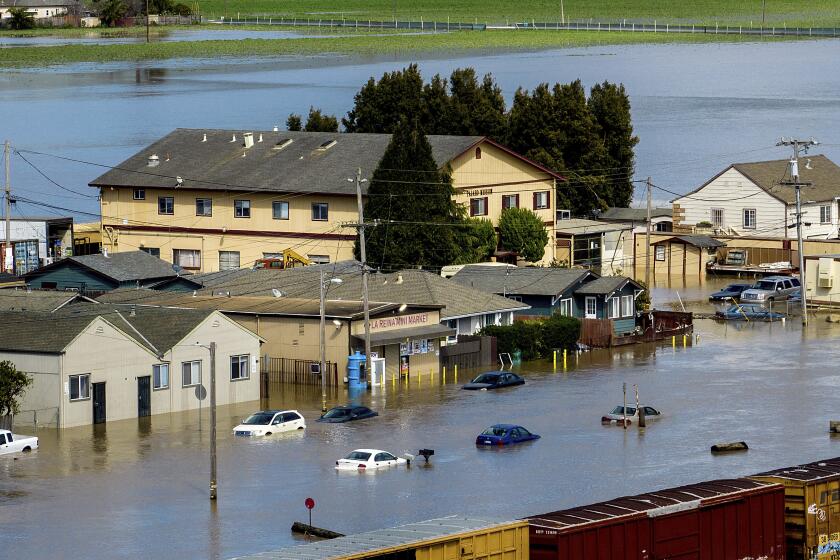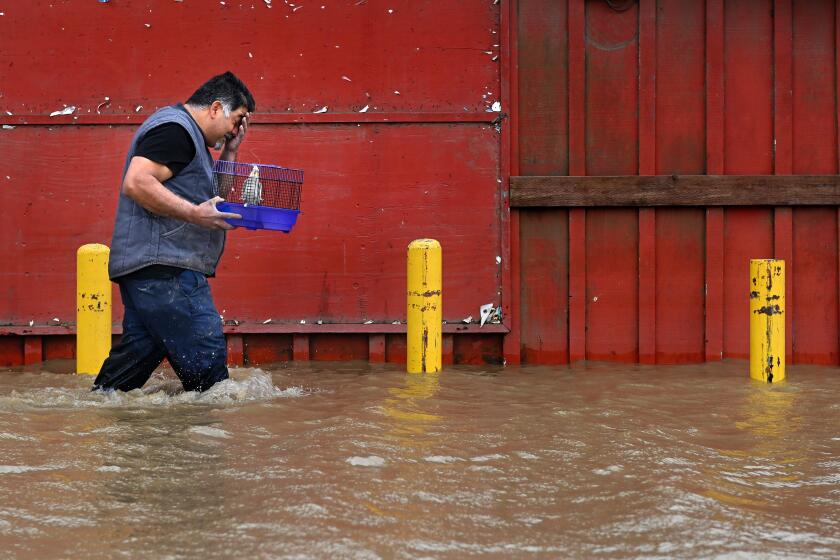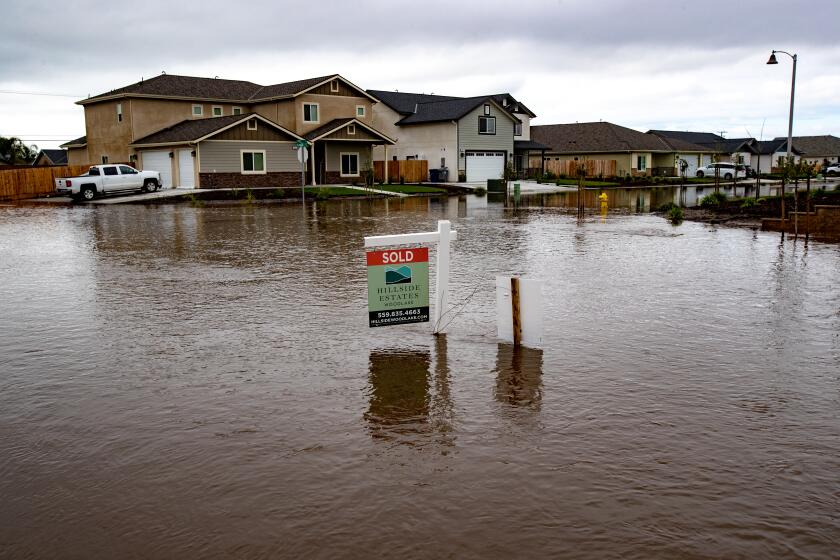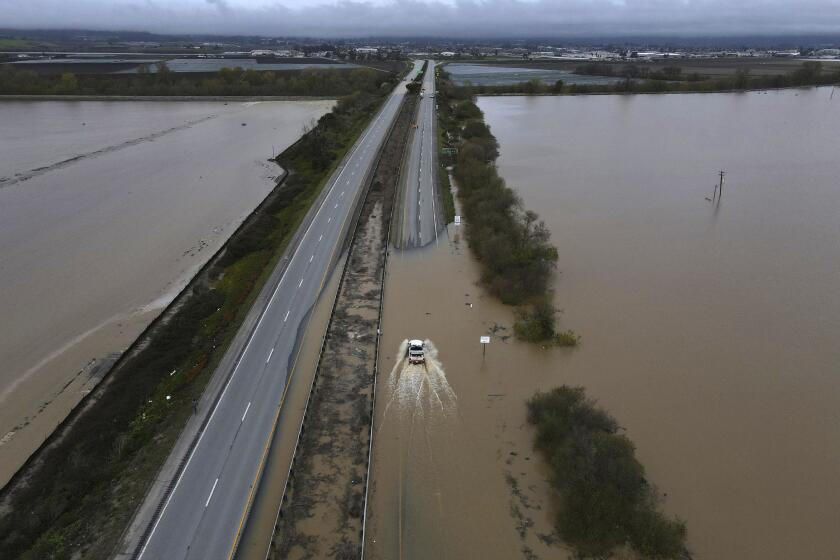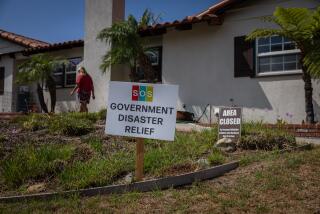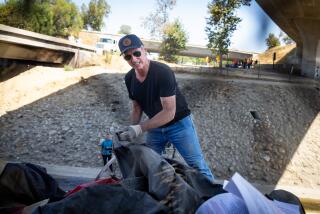Volunteers step up in flooded Pajaro, where many lack food, clothing â and work
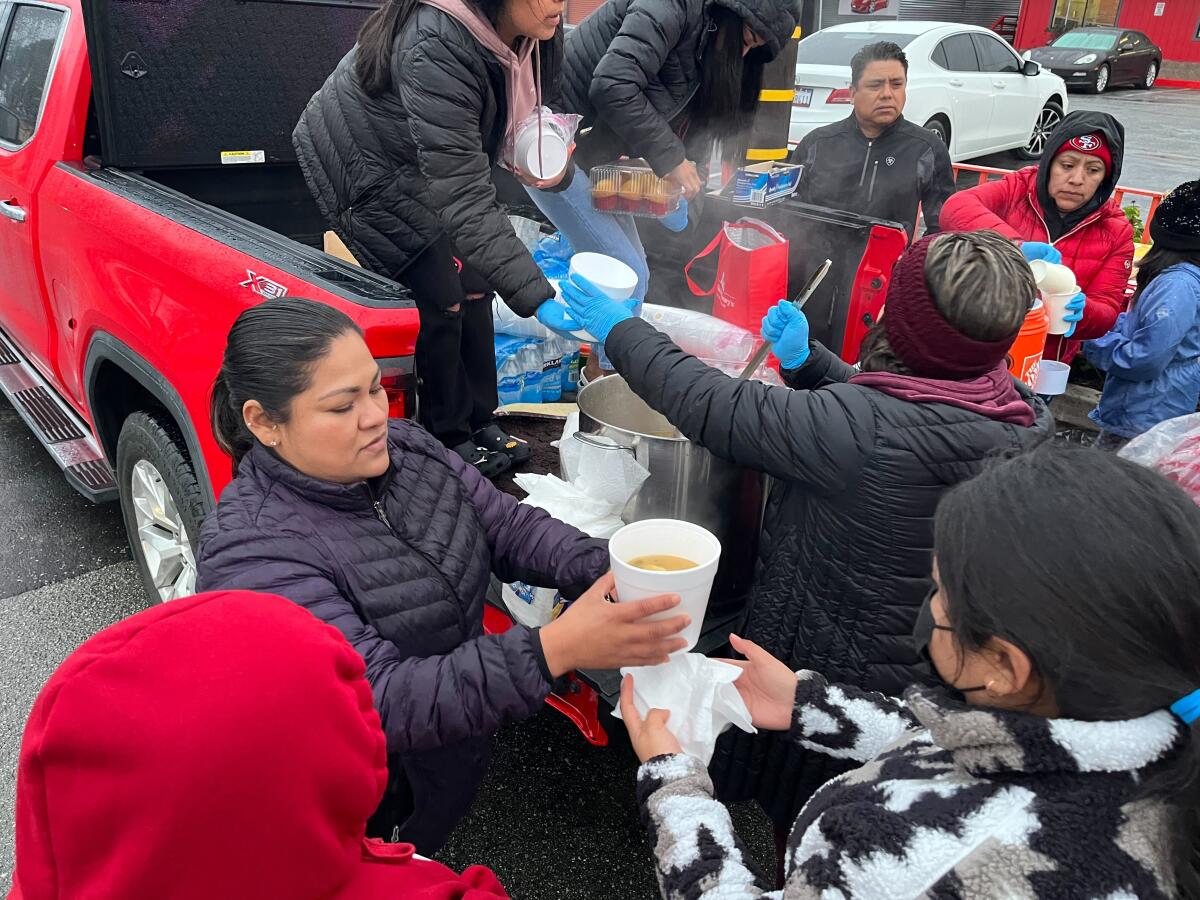
PAJARO, Calif. â Jessica Sanchez felt awful about the catastrophic flooding that displaced hundreds of people in this Monterey County farm town.
She felt worse when she heard families were sleeping in their cars because some of the shelters had reached capacity and they couldnât afford hotels.
âI have two daughters and I canât imagine having to sleep in a car when itâs cold and raining outside,â said Sanchez, 34. âThereâs also the fear of a tree falling on them.â
So Tuesday night, she and her friend Sara Perez, 36, joined a group of volunteers to feed those affected by the flood that occurred when the Pajaro River breached a levee late Friday.
The two women handed out foam containers of chicken soup, pan dulce and cups of atole, a hot Mexican drink, near the Pajaro River bridge in Watsonville, across the water from Pajaro.
Sanchez said it was only the second day they had come together to feed families after at least 70 people, including children, showed up Monday.
âWe ran out of food, and I felt so terrible because people were still showing up with their children,â she said.
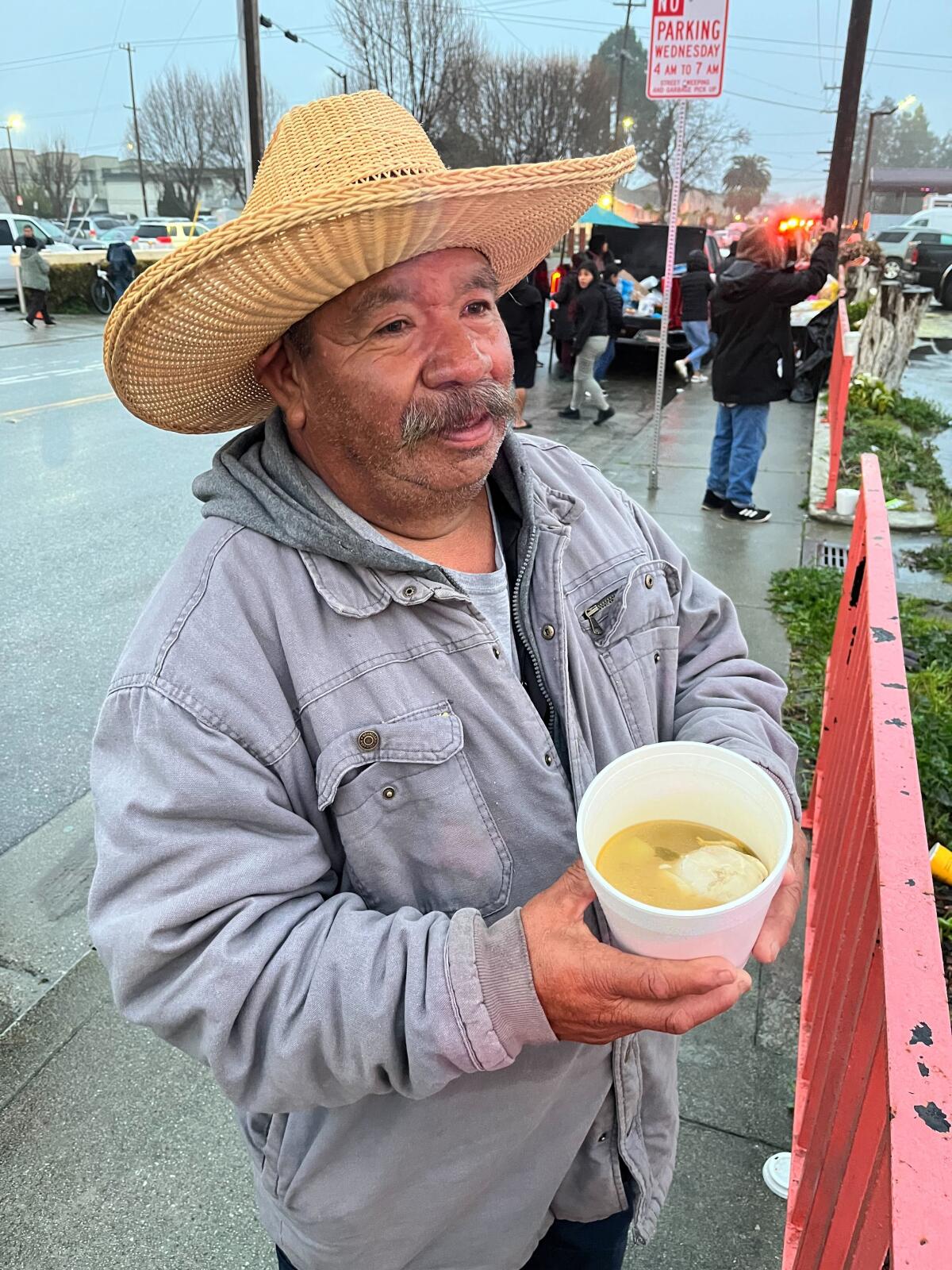
More than 70 people came again Tuesday night. Some drove, others stepped out of their cars and made their way to the food lines, and some walked across the bridge from their homes in Pajaro with their children.
The families were mostly those from two-story apartment buildings who had refused to evacuate. The town has power and gas but no potable water. Residents collected rainwater that they could use to flush toilets.
At the bridge, volunteers handed out tacos and hot chocolate over police tape that kept people from trying to get back inside Pajaro. A security guard helped pass cases of water to the families.
The arched bridge over the Pajaro River connects the towns of Watsonville and Pajaro, two communities varying in size and economic power.
The migrant town of Pajaro, Calif., was flooded last week during powerful storms that caused a levee to break. Now, another storm is moving in.
Watsonville, located in Santa Cruz County, has a population of nearly 53,000 and a diverse economy including agricultural and manufacturing sectors. Pajaro is lined with mom-and-pop stores and has roughly 3,000 residents, most farmworkers.
Despite being in different counties, they share the same ZIP Code. For people like Perez, theyâre closely intertwined through agricultural work.
âEven though they live on the other side of the river, theyâre our compatriots, our friends and coworkers,â she said. âThatâs the other sad thing about all this is that some of us work picking strawberries over there, and now thereâs no work for anyone.â
The women said the flooding has hurt farmworkers on both sides of the river, many of whom had been expecting to start work this week.
Pajaro is a community of âmostly Latino, low-income farmworkers and immigrants â people who are salt of the earth, but the people who have the most to lose here,â Monterey County Supervisor Luis Alejo said at a news briefing Wednesday, noting that many residents are undocumented. âThey have so little, but they have lost so much.â
In a visit to Pajaro, Gov. Gavin Newsom said he was âcommitted to this community,â announcing that the United Way had secured $42 million from the U.S. Department of Agriculture to assist farmworkers affected by flooding and will begin sending $600 checks immediately, regardless of recipientsâ immigration status. Other aid, including emergency food supplies from the CalFresh disaster program, is coming as well, Newsom said.
The area âdoesnât get a lot of attention,â Monterey County Supervisor Glenn Church said at the briefing.
âThis isnât the first time this has happened,â he said. âThe levee was built in â49. This is the fifth or sixth time that weâve had a flood down here.â
Newsom visits inundated Pajaro, where a levee breach has displaced hundreds. Porterville residents evacuate as Lake Success overtops the Schafer Dam spillway.
Officials knew for decades that the levee was vulnerable to failure but never prioritized repairs because they believed it did not make financial sense to protect the low-income area, a Times report found this week.
Newsom spoke critically Wednesday of the problem going unresolved for so long.
âThe infrastructure that was built in the 1950s is no longer relevant to the world weâre living in ⌠and the weather whiplash that all of us are struggling and suffering through in this state,â he said. âWe have to move with speed, and we have to move more deliberately and in a much more collaborative spirit with the federal government that bears, as you know, a big part of the responsibility,â including the U.S. Army Corps of Engineers and the Central Valley Project, a federal water management network.
A project to improve the Pajaro River levee system is anticipated to go to construction in 2024 and has so far received $67 million from the $1.2-trillion infrastructure bill signed by President Biden in 2021 â the first in a series of federal investments in the $400-million project.
In addition to those funds, Newsom said he has committed nearly $140 million in state funds to match project costs and help fix the levee. However, the process could take five to seven years to complete.
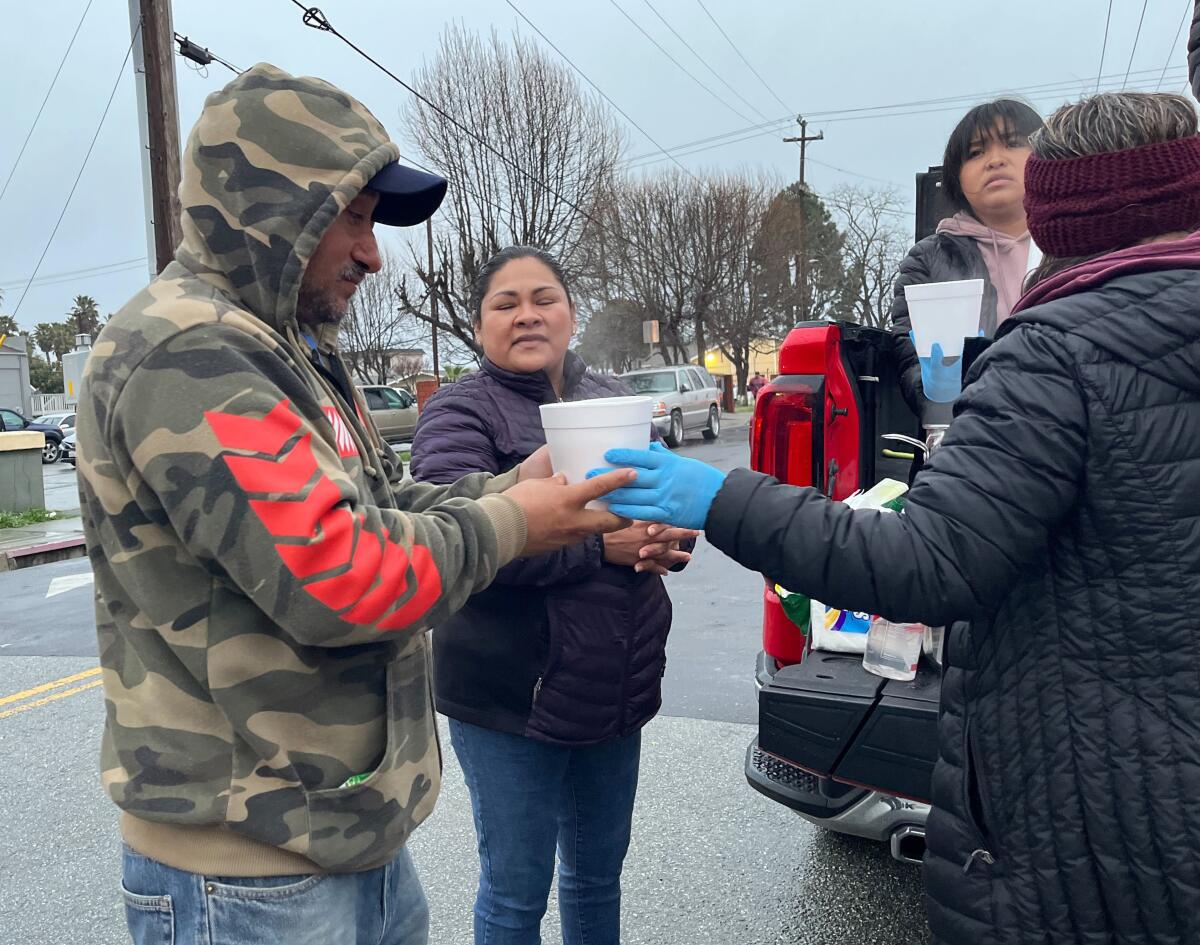
Still, Sanchez and Perez said they were disappointed that Santa Cruz and Monterey counties had not done more to help families. Some of the flooded residents speak indigenous languages and canât communicate well in Spanish.
âI knew of one woman at a shelter that wanted a blanket for her grandson, but she didnât speak English and she didnât speak Spanish really well,â Sanchez said. âI had a friend who was able to help translate for her.â
Officials have not distributed clothes for people who had to leave in the middle of the night without having time to grab things, the women said.
âSome people have been wearing the same clothes for days now; they have no money and canât afford to go to hotels,â Sanchez said.
She said one volunteer spent about $200 on food alone; another has used his money to distribute toiletries and socks.
Monterey County officials said theyâre aware residents have been demanding that the county do more. The last 48 hours presented many challenges, including a lack of staffing to open more shelters complicated by the closure of several major roadways, they said.
âI get it, and my job is to listen and try to resolve those and bring those resources in as soon as possible,â Alejo said. âWe can always do more.â
As residents salvage what they can from flooded homes in Woodlake, some point to a new housing development that replaced orchards and a creek bed, possibly compromising drainage.
More shelters have been opened, Alejo said, adding that he has asked United Way to set up a portable resource center by the Pajaro River bridge for residents who are unable to go to the county fairgrounds for aid. He also called on the Federal Emergency Management Agency to assist with recovery efforts.
Deputies are trying to help escort people to collect medications, Monterey County Sheriff Tina Nieto said.
âAll we ask is for a little patience,â Nieto said. âWe get it, everyone needs help.â
Taking sips of his chicken soup at the Pajaro River bridge, displaced resident Heriberto Garcia, 66, said he was grateful that volunteers were distributing food. He couldnât understand why the county didnât send workers to residents instead of having people go to them.
After Pajaro flooded in 1995, killing two people and causing up to $95 million in economic damage, Garcia said he was hired to help pump water out of the inundated fields.
He said he hopes something similar will happen soon, because he has no money for his $2,200 rent next month.
For years, experts had been warning Monterey and Santa Cruz County that the levee along the Pajaro River could fail.
Nearby, Jose Aguirre, 45, ate a plate of chips.
âIâm very grateful for everyone here for bringing food while we wait to get back into our homes,â he said. âIt helps us save a little.â
Aguirre, a farmworker, said he was unable to find space at a shelter and had to rent a hotel room. Paying $103 a day for a room he and his wife share with their 15-year-old daughter, he has enough money to stay for three days, he said. Heâs unsure what heâll do next.
âWe donât have any work,â he said. âWe all need help, some more than others.â
He took a chip from his plate and gazed out as people continued to arrive at the bridge in search of a warm meal and a respite from the floodwaters.
Times staff writer Hayley Smith contributed to this report.
More to Read
Sign up for Essential California
The most important California stories and recommendations in your inbox every morning.
You may occasionally receive promotional content from the Los Angeles Times.
